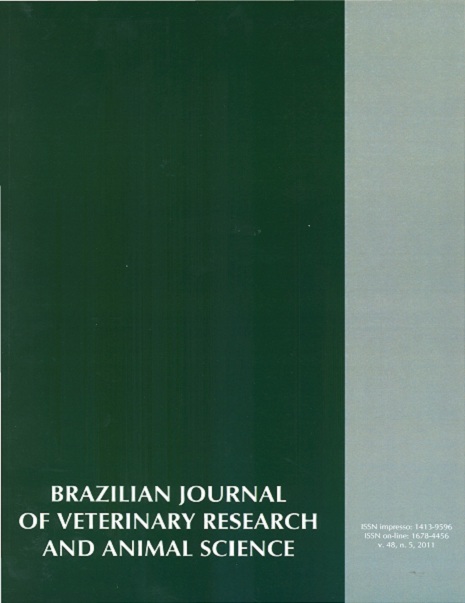Risk factors for feline leukemia virus (FeLV) infection in cats in São Paulo, Brazil
DOI:
https://doi.org/10.11606/S1413-95962011000500006Keywords:
Cats, Feline leukemia virus, Risk factors, Epidemiology, FeLVAbstract
The aim of this study was to identify risk factors for feline leukemia virus (FeLV) infection in cats (n = 812) from the city of São Paulo. Information on age, gender, outdoor access, reproductive status, origin and number of potential contacts were obtained for each animal. Direct immunofluorescence test was used to identify the infected cats. Fifty cats (6.2 %) were positive for FeLV infection. The risk factors identified were "outdoor access" (OR = 47.2; p < 0.001), "having been rescued from the street" (OR = 3.221; p = 0.008) or being three to six year old (OR = 3.046; p = 0.009); the most important risk factor was free outdoor access. A predictive model for FeLV infection was built based on the results of the multivariate analysis. Cats with free outdoor access are more predisposed to infection, with 18% more chances of becoming infected. If the animal is one to three year old, the probability increases, reaching 34%. If the cat is exposed to these three risk factors, the probability of infection is even higher (63%). When analyzed together or as isolated risk factors, the age and being rescued from the street represent less impact on the spreading of the FeLV, as the probability of infection for cats exposed to each of these risk factors is 1 and 4%, respectively. Thus, free roaming and outdoor access are the most important risk factors associated to FeLV infection among cats in São Paulo city and must be taken in consideration in the prevention of this retrovirus infection.Downloads
Download data is not yet available.
Downloads
Published
2011-10-01
Issue
Section
UNDEFINIED
License
The journal content is authorized under the Creative Commons BY-NC-SA license (summary of the license: https://
How to Cite
1.
Jorge JJ, Ferreira F, Hagiwara MK. Risk factors for feline leukemia virus (FeLV) infection in cats in São Paulo, Brazil. Braz. J. Vet. Res. Anim. Sci. [Internet]. 2011 Oct. 1 [cited 2024 Apr. 24];48(5):392-8. Available from: https://www.revistas.usp.br/bjvras/article/view/34405





